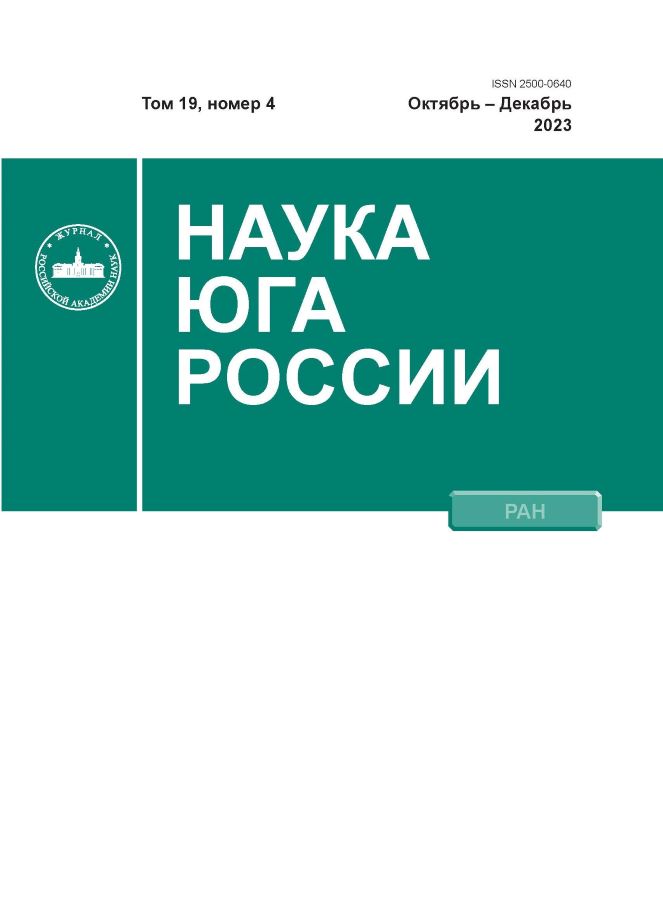Variability Of Morphological Features Of Needle Juniperus Excelsa M.-BIEB. In Mountain Crimea
- Authors: Korenkova O.O1
-
Affiliations:
- National Research University
- Issue: Vol 19, No 4 (2023)
- Pages: 74-84
- Section: Articles
- URL: https://journals.eco-vector.com/2500-0640/article/view/628061
- DOI: https://doi.org/10.7868/S25000640230407
- ID: 628061
Cite item
Abstract
In the course of the studies, within the population of J. excelsa in the Crimean Mountains, 2 types of needles were identified: scaly and acicular. Most individuals (81%) have scaly species-specific needles, which are of two types – green and glaucous. It has been established that the tip of the needles of J. excelsa can be of several types – entire pointed, serrated and forked. The degree of bifurcation varies from narrowly bifurcated (divergence angle up to 5°) to widely bifurcated (angle – 30°). With the same frequency, these tip shapes are found in both scaly and acicular needles. In order to identify the adaptive ability of the vegetative organs of J. excelsa, an integral indicator was calculated – the total area of the assimilating apparatus. It was revealed that the western part of the range is characterized by a two times smaller total area of the assimilating apparatus than the southern and eastern parts, where this figure is 99.87 мм2. These territories turns to be the closest in terms of soil and climatic conditions to the main Mediterranean part of the range. Acicular needles are more susceptible to external factors than scaly needles. As a result of assessing the degree of leafiness of the shoot with acicular needles, a significant inverse relationship (r = −0.32) on its length was established, which was not the case for the scale-like needles of J. excelsa. The indicators of shoots leafiness of individuals of the western and eastern groups differ by two times. The strength of the influence of the regional factor is the maximum value for the needles of J. excelsa – 69.63%. In general, the acicular type of needles shows much more adaptive features, as a result the total area of the assimilating apparatus increases. Thus, the acicular needles of J. excelsa can be considered as one of the mechanisms of adaptation to soil and climatic conditions at the northern border of the range.
Keywords
About the authors
O. O Korenkova
National Research University
Email: o.o.korenkova@mail.ru
Moscow, Russian Federation
References
- Плугатарь Ю.В. 2015. Леса Крыма. Симферополь, АРИАЛ: 385 с.
- Плугатарь Ю.В., Коренькова О.О., Коба В.П. 2022. Сезонный рост побегов Juniperus excelsa M.-Bieb. в Горном Крыму. Бюллетень Государственного Никитского ботанического сада. 143: 64–71. doi: 10.36305/0513-1634-2022-143-64-71
- Фатерыга В.В. 2015. Можжевельник высокий. В кн.: Красная книга Республики Крым. Растения, водоросли и грибы. Симферополь, АРИАЛ: 64
- Фатерыга В.В., Бондарева Л.В. 2018. Можжевельник высокий. В кн.: Красная книга города Севастополя. Калининград ‒ Севастополь, РОСТ-ДОАФК: 30.
- Дегтерев А.Х. 2020. Изменение климата Крыма за последние десятилетия. Вопросы безопасности. 2: 1–6. doi: 10.25136/2409-7543.2020.2.32821
- Ергина Е.И., Жук В.О. 2022. Анализ и оценка процессов опустынивания в Крыму. Известия высших учебных заведений. Северо-Кавказский регион. Серия: Естественные науки. 2(214): 47–52. doi: 10.18522/1026-2237-2022-2-47-52
- Ларина Т.Г. 2008. Природно-антропогенный комплекс заказника «Байдарский». Симферополь, Н. Оріанда: 56 с.
- Корсакова С.П., Корсаков П.Б., Багрикова Н.А. 2020. Климатогенные изменения и прогноз сроков пыления Juniperus deltoides (Cupressaceae). Наука Юга России. 16(3): 40–52. doi: 10.7868/S25000640200305
- Князева С.Г. 2012. Морфолого-анатомические особенности хвои можжевельника обыкновенного (Juniperus communis L.). Хвойные бореальной зоны. 1/2: 92–96.
- Коба В.П. 2002. Рост и развитие вегетативных структур Pinus kochiana Klotzsch ex. C. Koch. в связи с действием лимитирующих факторов. Лесной вестник. 2: 19–23.
- Carmona-Velasco J., García-Cervigón A.I., Casimiro-Soriguer R. 2022. Population and reproductive structure of an endangered juniper from coastal pine forests. Journal for Nature Conservation. 67: 126178. doi: 10.1016/j.jnc.2022.126178
- Muldavin E., Triepke F.J. 2020. North American pinyon-juniper woodlands: ecological composition, dynamics, and future trends. In: Encyclopedia of the World’s Biomes. Elsevier: 516–531. doi: 10.1016/B978-0-12-409548-9.12113-X
- Al Farsi Kh.A.A.Y., Lupton D., Hitchmough J.D., Cameron R.W.F. 2017. How fast can conifers climb mountains? Investigating the effects of a changing climate on the viability of Juniperus seravschanica within the mountains of Oman, and developing a conservation strategy for this tree species. Journal of Arid Environments. 147: 40–53. doi: 10.1016/j. jaridenv.2017.07.020
- Сергеев П.Н. 1953. Лесная таксация. М., Гослесбумиздат: 311 с.
- Лакин Г.Ф. 1990. Биометрия. М., Высшая школа: 350 с.
- Исиков В.П., Плугатарь Ю.В., Коба В.П. 2014. Методы исследований лесных экосистем Крыма. Симферополь, АРИАЛ: 252 с.
- Коренькова О.О. 2015. Морфологические особенности хвои крымской популяции Juniperus foetidissima Willd. Ученые записки Крымского федерального университета имени В.И. Вернадского. Биология, химия. 1(67)(1): 54–59.
- Киричок Е.И. 2016. Онтогенез можжевельника высокого (Juniреrus ехсеlsа М. Вiев) в редколесьях Черноморского побережья Крыма и Кавказа. Russian Journal of Ecosystem Ecology. 1(3): 1–22. doi: 10.21685/2500-0578-2016-3-4
- Колесников А.И. 1974. Декоративная дендрология. М., Лесная промышленность: 704 с.
- Алексеев Ю.Е., Жмылев П.Ю., Карпухина Е.А. 1997. Деревья и кустарники. Энциклопедия природы России. М., ABF: 592 с.
- Деревья и кустарники СССР. Том 1. Голосеменные. 1949. М. ‒ Л., изд-во Академии наук СССР: 465 с.
Supplementary files









